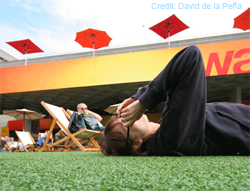Track and field, ultimate Frisbee, soccer, baseball, running free during recess… many of us cherish the memories we make “on the field.” But what happens when grass is replaced with artificial turf, some with health threats lurking in their bright green blades of “grass?”
As it turns out, some artificial turfs contain high levels of lead and other potentially hazardous materials from the crumb fill.
Artificial turfs have put many parents in a hard position, as they pop up around the country. It’s a complex issue. On one hand, proponents argue that synthetic fields require less water and pesticides, and can therefore pose some environmental benefits. On the other hand, some synthetic turfs are made from dangerous materials that have the potential to
cause harm. So what are we to do?
Here’s what we know:
- Lead may be lurking: According to the CDC, lead was found in some artificial turfs, posing a risk of lead exposure from playing on or inhaling dust from the field. Several turfs were closed due to concerns about high levels of lead (in New Jersey and New York).
- Inherently toxic material: Many of the turfs are made from plastic, which may use lead as a “plasticizer” (a way to soften the plastic). The process for developing these plastic materials creates pollution all along the lifecycle of the product. Manufacturing pollutes communities near the facilities, harms people while they are in use, and have the potential to leach toxic chemicals into the groundwater while installed or in landfills. Even the “safer” fields made from petroleum-based polypropylene plastic.
- Old tires used as “fill”: The fill used to make the turfs soft and give structure to the synthetic blades are often made from old tires. Recycling seems like a good thing, but according to the EPA, old tires can contain dozens of harmful chemicals including: arsenic, benzene, halogenated flame retardants, mercury and toluene.
- Sierra Club files lawsuit: Our partners at the Sierra Club have filed a lawsuit against the city of San Francisco for failing to consider safer turf alternatives and potentially putting children’s health at risk.
- Parents speak out: Parents across the country are raising concerns about synthetic turfs popping up at their children’s schools and local community parks. This amazing mom from Los Angeles is taking matters into her own hands to protect her family. Read more at her blog One Fabulous Mom.
- Maryland’s aggressive push towards synthetic turfs: A proposed bill in Maryland would convert Prince George’s county public school fields to synthetic turf by the year 2018. Many residents are concerned both about health and environmental impacts from the fields.
Why are harmful substances in synthetic turfs in the first place?
Shouldn’t we have a system in place that ensures the products we encounter are safe? Whether it’s an artificial turf, couch, or household cleaner, the products we buy and come in contact should be made of materials that do not pose a threat to our health.
Our federal laws on toxic chemicals are out of date and not working. Due to broken federal laws, we continue to encounter toxic materials throughout our day. The issue is not simply confined to our homes, and can extend to fenceline communities that face water and soil contamination from manufacturing facilities. That’s why our coalition is advocating for the Safe Chemicals Act, a bill that would put common sense limits on toxic chemicals.
Prevent and reduce lead exposure from artificial turfs:
- Wash hands and shower after coming into contact with the turf. By washing hands and your body, you can reduce lead exposure that may come into contact with the skin.
- Avoid eating and hand-to-mouth actions while in contact with the turf (in other words, this is no place for a picnic!)
- Shake off the crumb and rubber fill used in the turf before hopping into your car and heading home.
- Avoid eating or ingesting the rubber fill.
- Ask your school or park to maintain the turf. Keeping it clean and free of particles decreases the chances of transferring lead to your skin and body.
Does the turf in your community contain lead?
Not all turfs contain lead and our friends at the Center for Environmental Health test turfs for free! Find out how to submit a sample here.
Interested in stopping an artificial turf from being built in your community?
Five tips to get started:
- Host an informational meeting with other concerned parents and community members. Bring information on the health and environmental threats associated with artificial turfs to educate the group.
- Set up a meeting with the school or local park board to voice your opposition. Bring in a small group of concerned citizens to talk through the health and environmental issues with the turf. Be sure to give the decision makers information on the health and environmental threats from these turfs and offer to work together on any issues around maintaining a grass
field. - Offer solutions for pesticide-free green and healthy lawn. There is a wealth of information and many success stories of schools who have kept their grass fields and used integrated pest management systems to decrease or eliminate the use of pesticides.
- Have members of your community send in letters to the editor of your local newspaper. These letters are usually around 150 words (check the submission instructions with your newspaper), and are a great way to spread the word. These can educate other members of the community and encourage them to voice their concerns, or call out stubborn decision makers.
- Use the power of social media to spread the word. Start an online petition and use social media to collect petition signatures. You can also connect with local bloggers, reporters and allies and ask them to write about the issue and share online!
Fired up? Take action now!




